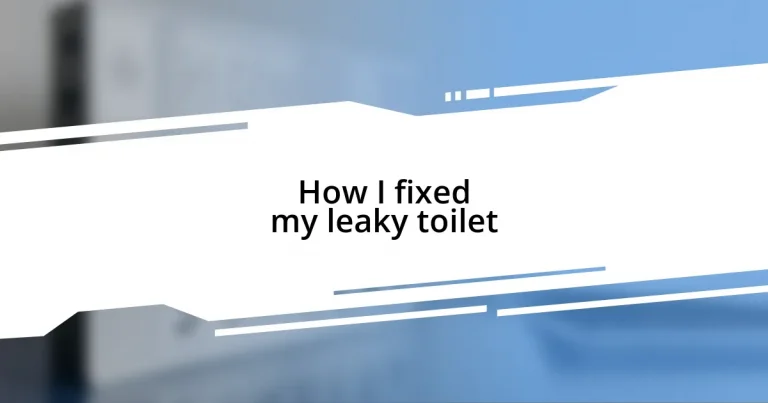Key takeaways:
- Gather essential tools and materials before starting the repair to avoid delays and frustration.
- Shut off the water supply to prevent flooding during the repair process.
- Identify and replace damaged parts, such as the flapper or gaskets, to resolve leaks effectively.
- Reassemble the toilet carefully and test it to ensure there are no leaks and that it functions properly.

Gather necessary tools and materials
When I faced the frustration of my leaky toilet, my first step was to gather the necessary tools and materials. I quickly learned that having the right items on hand can save time and prevent aggravation. For this job, you’ll typically need an adjustable wrench, a flat-head screwdriver, a replacement flapper, and a bucket to catch any excess water. Can you imagine diving into a project only to realize you’re missing a critical tool?
As I rummaged through my toolbox, I felt a sense of anticipation mixed with a hint of anxiety. I had a few old sponges and towels ready too, just in case the water splashed more than I expected. It’s amazing how those small preparations can ease your mind. By the way, don’t forget the new toilet gasket! It may seem minor, but it plays a big role in preventing future leaks.
If you’re diving into this DIY adventure, double-check the water supply line and valves for any wear as well. I remember feeling relieved when I discovered all my materials were together, making the task less daunting. It’s like assembling a recipe before cooking; having everything in place can make your experience smoother and even a bit enjoyable!

Shut off the water supply
To begin the repair process effectively, the first action I took was to shut off the water supply to the toilet. This crucial step is usually located near the base of the toilet or behind it. I can’t emphasize enough how important it is to know how to turn off the water before diving into any plumbing project—this simple action can save you from a mini flood if things go awry.
I distinctly remember when I first encountered a leaky toilet, I wasn’t entirely sure where to find the shut-off valve. It took me some time to locate it, hidden behind the toilet. Once I finally turned it off, relief washed over me—not just because the water stopped flowing, but because I knew I could now tackle the repair with confidence and without the pressure of a running water source. Have you ever been in a situation where you felt out of control? That calm moment made all the difference for me.
It’s worth noting that some toilets may have different shut-off valve types, such as ball valves or gate valves. If you’re uncertain about which type you have, take a moment to inspect it before proceeding. From my experience, understanding these small details can make a big difference during your repair process, easing future tension and issues.
| Valve Type | Description |
|---|---|
| Ball Valve | A round, lever-style handle that easily turns off water with a quarter turn. |
| Gate Valve | A wheel-style handle that requires several turns to shut off the water. |

Replace damaged parts if needed
When I finally assessed the situation, I realized that not all parts of my toilet were in perfect condition. Sometimes, those pesky leaks stem from a worn flapper, cracked tank, or damaged seal. Replacing these damaged parts is essential because, often, it’s a simple fix that can dramatically improve performance and save water.
Here’s a handy list of parts you might need to consider replacing:
– Flapper: If it’s warped or cracked, it won’t seal properly.
– Tank-to-bowl gasket: A worn gasket can cause leaks between your toilet tank and bowl.
– Fill valve: If it’s noisy or constantly running, it might need a replacement.
– Flush valve: Check for cracks; they can lead to water escaping.
– Supply line: Older lines can become corroded and may need replacing for a secure fit.
I can still remember the feeling of surprise when I discovered that the flapper was responsible for my leaks. It looked so small and insignificant, yet it played such a critical role in my toilet’s functionality. By making that simple swap, I felt a wave of satisfaction wash over me. You know, it’s often the little things in life, like a functioning toilet, that we take for granted until they go wrong!

Reassemble the toilet and test
Once all the damaged parts are replaced, it’s time to reassemble the toilet. I remember the first time I was putting everything back together; I was a bit nervous, second-guessing whether I had tightened everything sufficiently. As I aligned the tank with the bowl and secured the bolts, I felt a mix of anticipation and hope. Would I hear that satisfying flush or would there be another leak?
After reassembling everything, I connected the water supply line. I took a deep breath before turning the water back on, my heart racing just a bit. It felt like I was on the brink of either victory or defeat. Once the water filled the tank, I couldn’t help but feel a twinge of excitement as I prepared to test the toilet. It’s that initial flush that really makes your heart skip a beat, doesn’t it?
When I finally pulled the handle, I was flooded with relief as the sound echoed in the bathroom—no leaks! I watched the water swirl and felt a wave of accomplishment. You know that feeling when a weight is lifted off your shoulders? That’s exactly how I felt. Testing the toilet isn’t just a final step; it’s a celebration of your efforts and skills. Plus, there’s nothing quite like the peace of mind knowing that there’s no drips or puddles waiting for you when you step out of the bathroom!














